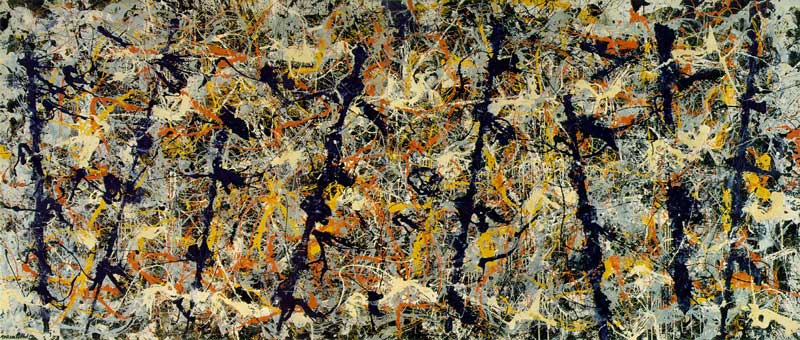by Dahlia Scheindlin
A visual expression of the Israeli election campaign would look a lot like a Jackson Pollock painting. All of the parties running were required to finalize their lists on Thursday, and declare whether they would merge, split or stay single-by-choice. For 24 hours before the deadline, the parties darted around in a strategic frenzy accompanied by the relentless whine of 1,000 blooming rumors.
The latest changes should be seen in the context of the earlier dramas in the political system.
Start with the center and left: When elections were called, a new party led by former Chief of Staff Benny Gantz sprung up in the center of the Israeli political map, draining votes from the existing center party, Yesh Atid, and from Labor on the center-left. The new Labor leader, Gabbay, was failing in his attempt to tack right so, naturally, he lopped off his more centrist co-leader, Tzipi Livni. This week, Livni pulled out of the race entirely, after surveys showed her party failing to cross the electoral threshold. Yair Lapid saw his support flow with centripetal force towards Gantz. As the latter consistently won more votes in surveys, Lapid finally consented to join up with Gantz and take second spot, to maximize votes. The two banded together with former generals Moshe Ya’alon and Gabi Ashkenazi to form the “Blue and White” party.
The Israeli right wing can be faulted for many things, but not for complacency. Earlier in the campaign cycle, Jewish Home, the main party to the right of Netanyahu, broke apart: Naftali Bennett and Ayelet Shaked left to form the “New Right.” The old Jewish Home party – well-stocked with extremists – was left competing for right-wing religious votes with both Bennett and a fringe party of fanatics called “Jewish Power.” Netanyahu’s reaction was a bit frenzied. In addition to indiscriminately firing off his poison arrows of “Left! Weak” at anyone in the Gantz crowd, Netanyahu cancelled a meeting with Vladimir Putin, a not-unimportant figure, to stay home and bribe the Jewish Home and the fanatics to merge as well. He promised them two ministerial positions if he wins, and they agreed to run on a joint slate — at the prime minister’s request.
What does all this mean? Do these changes have any significant impact on the ideological “blocs,” the alignment of parties into left, center, and right? And if so, will it influence the chances of a change of government in Israel? At least for analytic purposes, can a Pollock turn into a Gainsborough?
So far, there is no indication that the ideological breakdown of Israeli voters themselves has changed: about 45 percent still self-define as right wing, roughly one-quarter as centrists, and 20 percent as left wing. Since Jews vote at a significantly higher rate than Arabs, the breakdown among Jews is even more relevant: about 55 percent say they are right wing and just 15 percent left. The size of the center doesn’t change much but the center and left combined total just over 40 percent – hence the right wing still wins.
The few new surveys as of this writing show the new Gantz-Lapid party winning 35 or 36 seats – one showed this rise coming at Likud’s expense — but little change in the bloc breakdowns. Moreover, these initial strong showings reflect the bounces and shocks of the latest news rather than numbers that can predict election day results.
It’s not as if the right is untouchable. The unification of three sinister parties splits the religious right-wing voters, who must now choose between the “crazies” and the New Right. In 2015 there was just one party for that segment (Jewish Home), and it only won eight seats.
Netanyahu may yet regret his bribe of offering ministerial posts to the Kahanists. Not only are some prominent people in the national religious community aghast and vowing not to vote for the Jewish Home merger; Roni Rimon, a savvy veteran political strategist who has worked all sides of the map proposed that some moderate right-wing voters would prefer to defect from the bloc altogether rather than support a future government with Betzalel Smotrich or Itamar Ben Gvir as Education or Housing Minister, as they reportedly asked. Netanyahu is also vulnerable himself. Any Likud voter fed up with Netanyahu still has two other secular right-wing parties to choose from: Kulanu (Kahlon) and Avigdor Liberman’s party (Israel Beitenu) – both of which will be running independently.
Yet that very fragmentation means that moderate right-wing voters still have many options before defecting blocs. Most of the votes for both Gantz and Lapid so far have come from the erstwhile Zionist Union (the now defunct union of Labor and Livni’s party). If Blue and White is the new Zionist Union – there isn’t really room for two parties to its left. After Labor and Meretz declined to merge and are running separately instead, it’s likely only one of them will survive on April 9.
Meanwhile, the Arab parties have re-organized themselves from one to two. They’ll probably both cross the 3.25 percent threshold but it’s unlikely they’ll get more than the 13 seats they currently hold.
As the dust settles then, the big picture looks much like it did before the big collisions and reconfigurations. The only route to change runs through the center – and the center needs the right. Blue and White could strip mine the old Zionist Union votes but that would still only give them 24 seats (Netanyahu is still polling at 30). To win, Blue and White needs voters to defect from the right.
Therefore, whether Netanyahu is indicted on corruption charges or not, we can expect to see Blue and White trying to look and sound more and more like a political home for the moderate right: bragging about bombing Gaza, or whatever fresh meat the generals believe right-wing Israelis need to devour. I personally find it demeaning to those voters, even on the other side of the map.
But there’s a deeper problem. In trying so hard to unseat Netanyahu, most view the new center as a “just-not-Netanyahu” party. The Blue and White list is an odd mixture of candidates, including three former Netanyahu associates.
Campaigns, I’m sorry to reveal, often force political hopefuls to generate ideas and vision they simply lacked before. People accuse politicians of breaking promises, but sometimes keeping them can be worse. A good example is Avigdor Liberman’s “no loyalty, no citizenship” slogan in 2009, which he translated into a series of racist and anti-democratic legislative efforts once in government.
If Gantz and Lapid become the campaign they are expected to run, following strategies to power instead of expressing a vision, they won’t change the country’s direction even if by a fluke they do win. We’re right to excoriate the Kahanists, but voters should really be demanding that the most likely challengers offer a genuine alternative.
Dahlia Scheindlin is a leading international public opinion analyst and strategic consultant based in Tel Aviv, specializing in progressive causes, political and social campaigns in over a dozen countries, including new/transitional democracies and peace/conflict research in Israel, with expertise in Eastern Europe and the Balkans. In Israel, she works for a wide range of local and international organizations dealing with Israeli-Palestinian conflict issues, human rights, peacemaking, democracy, religious identity and internal social issues in Israeli society. Dahlia holds a PhD in political science from Tel Aviv University, and she is the co-host of The Tel Aviv Review podcast. Reprinted, with permission, from +972 Magazine.





